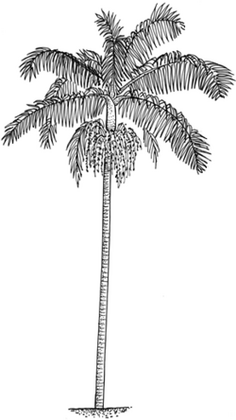Family Arecaceae
Synonyms: Palmae APNI*
Nypaceae APNI*
Palmae APNI*

Description: Plants arborescent, usually unbranched, or climbing, often with furrows and/or annular scars (formed by fallen leaf bases) on the trunk, dioecious or monoecious.
Leaves borne in a terminal crown or alternate on stems of climbers; lamina pinnately or palmately divided, rarely entire, occasionally spiny; petiole with a sheathing base, in some palms the bases much broadened and collectively forming a crownsheath that envelops and hides the bases of the upper leaves.
Inflorescence paniculate or spike-like, enclosed in one or more large spathes. Flowers actinomorphic, usually 3-merous, unisexual or bisexual. Tepals usually 6 in 2 more or less dissimilar whorls, tepals free or fused. Stamens 3, 6, 9–mnay, free or fused to each other or to perianth; anthers 2-locular, dehiscing by longitudinal slits [or apical pores]. Ovary superior, carpels usually 1–3, free or fused and ovary mostly 3-locular (absent or rudimentary in male flowers).
Fruit a berry or drupe, with 1 or sometimes 2, 3 or more seeds.
Distribution and occurrence: World: c. 190 genera, c. 2400 species, tropical & subtropical regions. Australia: 19 genera, c. 60 species, Qld, N.S.W., Vic., N.T., W.A.
External links:
Angiosperm Phylogeny Website (Family: Arecaceae, Order: Arecales)
Wikipedia Howea, a genus of 2 species, is endemic to Lord Howe Island; H. forsteriana (C. Moore & F. Muell.) Becc., the Kentia Palm, is widely cultivated as a houseplant. Many palms are frequently cultivated as ornamental and street plants, including species of Bismarckia, Brahea, Butia, Caryota, Chamaedorea, Chamaerops, Hyophorbe, Licuala, Phoenix, Ravenea, Rhapis, Rhopalostylis, Sabal, Syagrus, Trachycarpus, Washingtonia. Commercial species include Cocos nucifera (the coconut) and Calamus spp. (for rattan furniture). Syagrus and Cocos are included in the key to genera since they may become naturalised but are not further described here.
Text by A. K. Brooks (1993); edited KL Wilson (Jan 2013; May 2015)
Taxon concept:
Taxa not yet included in identification key
Washingtonia
| | Key to the genera | |
| 1 | Climbers | Calamus |
| Trees or shrubs | 2 |
| 2 | Leaves palmately divided (fan-shaped); flowers bisexual | Livistona |
| Leaves pinnately divided (feather-like); flowers unisexual
Back to 1 | 3 |
| 3 | Leaves to 1.5 m long | 4 |
| Leaves 2–7 m long
Back to 2 | 6 |
| 4 | Inflorescence spike-like, elongated, pendulous; no crownshaft; leaves with 6–12 pairs of pinnae irregularly shaped and arranged | Linospadix |
| Inflorescence panicle-like, spreading to drooping; crownshaft 20–50 cm long; leaves with numerous (>20) pairs of pinnae, regularly shaped and arranged
Back to 3 | 5 |
| 5 | Short crownshaft to 20 cm long, green with brown scurf | Lepidorrhachis |
| Elongated crownshaft to 50 cm long, glaucous
Back to 4 | Hedyscepe |
| 6 | Crownshaft 0.5–1 m long | 7 |
| No crownshaft
Back to 3 | 8 |
| 7 | Leaflets more or less flat and held in one plane on the frond; crownshaft green | Archontophoenix |
| Leaflets inversely V-shaped and held semi-erect in a V-shape on the frond; crownshaft glaucous
Back to 6 | Hedyscepe |
| 8 | Inflorescence spike-like, elongated, pendulous | Howea |
| Inflorescence panicle-like, spreading to drooping
Back to 6 | 9 |
| 9 | Leaves with large, stout spines near base of the stalk; trunk covered in rough leaf bases or rough diamond-shaped scars from fallen leaf bases | Phoenix |
| Leaves without spines; trunks smooth apart from rings (circular scars) from fallen leaves
Back to 8 | 10 |
| 10 | Fruit 10–35 cm long, with large central cavity filled with fluid | Cocos |
| Fruit 2–3 cm long, with small central cavity without fluid
Back to 9 | Syagrus |
|


